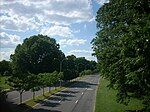Congregation Etz Hayim at Hollis Hills Bayside
Conservative synagogues in New York CitySynagogues completed in 1949Synagogues completed in 1960Synagogues in Queens, New York
Congregation Etz Hayim at Hollis Hills Bayside is a synagogue located in the neighborhood of Hollis Hills in Queens, New York. Congregation Etz Hayim at Hollis Hills Bayside is an egalitarian synagogue providing worship in the Conservative tradition. As of 2016, 240 families are members of the synagogue. The synagogue today reflects a consolidation of the Hollis Hills Jewish Center, the Bayside Jewish Center Jewish Center of Oak Hills, and Marathon Jewish Community Center.
Excerpt from the Wikipedia article Congregation Etz Hayim at Hollis Hills Bayside (License: CC BY-SA 3.0, Authors).Congregation Etz Hayim at Hollis Hills Bayside
211th Street, New York Queens
Geographical coordinates (GPS) Address Nearby Places Show on map
Geographical coordinates (GPS)
| Latitude | Longitude |
|---|---|
| N 40.7331384 ° | E -73.7601966 ° |
Address
Hollis Hills Jewish Center
211th Street
11427 New York, Queens
New York, United States
Open on Google Maps





